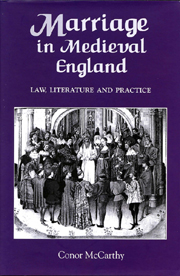Conclusion
Published online by Cambridge University Press: 12 September 2012
Summary
This book opened by arguing that some continuities in thinking about marriage are visible to a greater or lesser extent across the medieval period. Anglo-Saxon texts suggest that consent is important in marriage, at least as an ideal, long before the Church formulates its consensual model. Likewise, the importance of property in making marriages and the notion of marriage as alliance survive the introduction of the Church's emphasis on the consent of the partners. That love should be encouraged between spouses is a feature of thinking about marriage from Saint Paul to the later Middle Ages. Unease about the role of sex within marriage is found in Christian thinking throughout the medieval period. Attempts to make marriage both monogamous and indissoluble also persist. This is not to argue against the existence of historical change in medieval thinking about marriage. We can see movement, for example, from endogamous marriage to exogamous marriage, from limited polygamy towards monogamy, and a tendency away from bilineal notions of kinship and towards patrilineage. In the later medieval period, marriage becomes the subject of a body of law, secular and ecclesiastical, which is increasingly comprehensive and presumably influential. We might assume, therefore, that the Church in particular is more effective in implementing its views on marriage in the later part of the Middle Ages – but those views are still indebted to earlier medieval thinking. Continuities are visible across the medieval period, and changes that take place in medieval thinking about marriage are often changes of emphasis between elements that coexist in medieval marriage.
- Type
- Chapter
- Information
- Marriage in Medieval EnglandLaw, Literature and Practice, pp. 159 - 164Publisher: Boydell & BrewerPrint publication year: 2004



